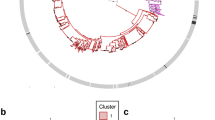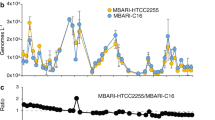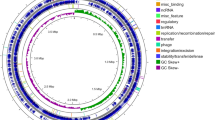Abstract
Genomic islands have been shown to harbor functional traits that differentiate ecologically distinct populations of environmental bacteria. A comparative analysis of the complete genome sequences of the marine Actinobacteria Salinispora tropica and Salinispora arenicola reveals that 75% of the species-specific genes are located in 21 genomic islands. These islands are enriched in genes associated with secondary metabolite biosynthesis providing evidence that secondary metabolism is linked to functional adaptation. Secondary metabolism accounts for 8.8% and 10.9% of the genes in the S. tropica and S. arenicola genomes, respectively, and represents the major functional category of annotated genes that differentiates the two species. Genomic islands harbor all 25 of the species-specific biosynthetic pathways, the majority of which occur in S. arenicola and may contribute to the cosmopolitan distribution of this species. Genome evolution is dominated by gene duplication and acquisition, which in the case of secondary metabolism provide immediate opportunities for the production of new bioactive products. Evidence that secondary metabolic pathways are exchanged horizontally, coupled with earlier evidence for fixation among globally distributed populations, supports a functional role and suggests that the acquisition of natural product biosynthetic gene clusters represents a previously unrecognized force driving bacterial diversification. Species-specific differences observed in clustered regularly interspaced short palindromic repeat sequences suggest that S. arenicola may possess a higher level of phage immunity, whereas a highly duplicated family of polymorphic membrane proteins provides evidence for a new mechanism of marine adaptation in Gram-positive bacteria.
Similar content being viewed by others
Log in or create a free account to read this content
Gain free access to this article, as well as selected content from this journal and more on nature.com
or
Accession codes
References
Achtman M, Wagner M . (2008). Microbial diversity and the genetic nature of microbial species. Nat Rev Microbiol 6: 431–440.
Acinas SG, Klepac-Ceraj V, Hunt DE, Pharino C, Ceraj I, Distel DL et al. (2004). Fine-scale phylogenetic architecture of a complex bacterial community. Nature 430: 551–554.
Ahlert J, Shepard E, Lomovskaya N, Zazopoulos E, Staffa A, Bachmann BO et al. (2002). The calicheamicin gene cluster and its iterative type I enediyne PKS. Science 297: 1173–1176.
Badger JH, Eisen JA, Ward NL . (2005). Genomic analysis of Hyphomonas neptunium contradicts 16S rRNA gene-based phylogenetic analysis: implications for the taxonomy of the orders ‘Rhodobacterales’ and Caulobacterales. Int J Syst Evol Microbiol 55: 1021–1026.
Barrangou R, Fremaux C, Deveau H, Richards M, Boyaval P, Moineau S et al. (2007). CRISPR provides acquired resistance against viruses in prokaryotes. Science 315: 1709–1712.
Berdy J . (2005). Bioactive microbial metabolites. A personal view. J Antibiot 58: 1–26.
Bose M, Barber RD . (2006). Prophage Finder: a prophage loci prediction tool for prokaryotic genome sequences. In Silico Biol 6: 223–227.
Buchanan GO, Williams PG, Feling RH, Kauffman CA, Jensen PR, Fenical W . (2005). Sporolides A and B: structurally unprecedented halogenated macrolides from the marine actinomycete Salinispora tropica. Org Lett 7: 2731–2734.
Burrus V, Pavlovic G, Decaris B, GuÈdon G . (2002). Conjugative transposons: the tip of the iceberg. Mol Microbiol 46: 601–610.
Cohan FM . (2002). What are bacterial species? Annu Rev Microbiol 56: 457–487.
Coleman ML, Sullivan MB, Martiny AC, Steglich C, Barry K, DeLong EF et al. (2006). Genomic islands and the ecology and evolution of Prochlorococcus. Science 311: 1768–1770.
Dobrindt U, Hochhut B, Hentschel U, Hacker J . (2004). Genomic islands in pathogenic and environmental microorganisms. Nat Rev Microbiol 2: 414–424.
Dondoshansky I, Wolf Y . (2000). BLASTCLUST, 2.2 edn. National Institutes of Health: Bethesda, MD.
Feling RH, Buchanan GO, Mincer TJ, Kauffman CA, Jensen PR, Fenical W . (2003). Salinosporamide A: a highly cytotoxic proteasome inhibitor from a novel microbial source, a marine bacterium of the new genus Salinospora. Angewandte Chemie 115: 369–371.
Fenical W, Jensen PR . (2006). Developing a new resource for drug discovery: marine actinomycete bacteria. Nat Chem Biol 2: 666–673.
Fenical W, Jensen PR, Palladino MA, Lam KS, Lloyd GK, Potts BC . (2009). Discovery and development of the anticancer agent salinosporamide A (NPI-0052). Bioorg Med Chem 17: 2175–2180.
Fischbach MA, Walsh CT, Clardy J . (2008). The evolution of gene collectives: how natural selection drives chemical innovation. Proc Natl Acad Sci USA 105: 4601–4608.
Fouts DE . (2006). Phage_Finder: automated identification and classification of prophage regions in complete bacterial genome sequences. Nucleic Acids Res 34: 5839–5851.
Fraser C, Alm EJ, Polz MF, Spratt BG, Hanage WP . (2009). The bacterial species challenge: making sense of genetic and ecological diversity. Science 323: 741–746.
Gevers D, Cohan FM, Lawrence JG, Spratt BG, Coenye T, Feil EJ et al. (2005). Re-evaluating prokaryotic species. Nat Rev Microbiol 3: 733–739.
Haeder S, Wirth R, Herz H, Spiteller D . (2009). Candicidin-producing Streptomyces support leaf-cutting ants to protect their fungus garden against the pathogenic fungus Escovopsis. Proc Natl Acad Sci USA 106: 4742–4746.
Hao W, Golding GB . (2006). The fate of laterally transferred genes: life in the fast lane to adaptation or death. Genome Res 16: 636–643.
Henderson IR, Lam AC . (2001). Polymorphic proteins of Chlamydia spp.—autotransporters beyond the Proteobacteria. Trends Microbiol 9: 573–578.
Henderson IR, Navarro-Garcia F, Desvaux M, Fernandez RC, Ala’Aldeen D . (2004). Type V protein secretion pathways: the autotransporter story. Microbiol Mol Biol Rev 68: 692–744.
Hsiao W, Wan I, Jones SJ, Brinkman FSL . (2003). IslandPath: aiding detection of genomic islands in prokaryotes. Bioinformatics 19: 418–420.
Hunt DE, David LA, Gevers D, Preheim SP, Alm EJ, Polz MF . (2008). Resource partitioning and sympatric differentiation among closely related bacterioplankton. Science 320: 1081–1085.
Jensen PR, Mafnas C . (2006). Biogeography of the marine actinomycete Salinispora. Environ Microbiol 8: 1881–1888.
Jensen PR, Williams PG, Oh D-C, Zeigler L, Fenical W . (2007). Species-specific secondary metabolite production in marine actinomycetes of the genus Salinispora. Appl Environ Microbiol 73: 1146–1152.
Joyce EA, Chan K, Salama NR, Falkow S . (2002). Redefining bacterial populations: a post-genomic reformation. Nat Rev Genet 3: 462–473.
Kim TK, Hewavitharana AK, Shaw PN, Fuerst JA . (2006). Discovery of a new source of rifamycin antibiotics in marine sponge actinobacteria by phylogenetic prediction. Appl Environ Microbiol 72: 2118–2125.
Kogure K . (1998). Bioenergenics of marine bacteria. Curr Opin Biotechnol 9: 278–282.
Konstantinidis KT, Tiedje JM . (2005). Genomic insights that advance the species definition for prokaryotes. Proc Natl Acad Sci USA 102: 2567–2572.
Kurtz S, Choudhuri JV, Ohlebusch E, Schleiermacher C, Stoye J, Giegerich R . (2001). REPuter: the manifold applications of repeat analysis on a genomic scale. Nucleic Acids Res 29: 4633–4642.
Maldonado LA, Fenical W, Jensen PR, Kauffman CA, Mincer TJ, Ward AC et al. (2005). Salinispora arenicola gen. nov., sp. nov. and Salinispora tropica sp. nov., obligate marine actinomycetes belonging to the family Micromonosporaceae. Int J Syst Evol Microbiol 55: 1759–1766.
Mincer TJ, Jensen PR, Kauffman CA, Fenical W . (2002). Widespread and persistent populations of a major new marine actinomycete taxon in ocean sediments. Appl Environ Microbiol 68: 5005–5011.
Ochman H, Lawrence JG, Groisman EA . (2000). Lateral gene transfer and the nature of bacterial innovation. Nature 405: 299–304.
Ochman H, Lerat E, Daublin V . (2005). Examining bacterial species under the specter of gene transfer and exchange. Proc Natl Acad Sci USA 102: 6595–6599.
Parche S, Nothaft H, Kamionka A, Titgemeyer F . (2000). Sugar uptake and utilisation in Streptomyces coelicolor: a PTS view to the genome. Antonie van Leeuwenhoek 78: 243–251.
Podell S, Gaasterland T . (2007). DarkHorse: a method for genome-wide prediction of horizontal gene transfer. Genome Biol 8: R16.
Podell S, Gaasterland T, Allen EE . (2008). A database of phylogenetically atypical genes in archaeal and bacterial genomes, identified using the DarkHorse algorithm. BMC Bioinformatics 9: 419.
Prince VE, Pickett FB . (2002). Splitting pairs: the diverging fates of duplicated genes. Nat Rev Genet 3: 827–837.
Reuther J, Gekeler C, Tiffert Y, Wohlleben W, Muth G . (2006). Unique conjugative mechanism in mycelial streptomycetes: a DNA-binding ATPase translocates unprocessed plasmid DNA at the hyphal tip. Mol Microbiol 61: 436–446.
Schultz AW, Oh D-C, Carney JR, Williamson RT, Udwary DW, Jensen PR et al. (2008). Biosynthesis and structures of cyclomarins and cyclomarazines, prenylated cyclic peptides of marine actinobacterial origin. J Am Chem Soc 130: 4507–4516.
Starcevic A, Zucko J, Simunkovic J, Long PF, Cullum J, Hranueli D . (2008). ClustScan: an integrated program package for the semi-automatic annotation of modular biosynthetic gene clusters and in silico prediction of novel chemical structures. Nucleic Acids Res 36: 6882–6892.
te Poele E, Bolhuis H, Dijkhuizen L . (2008). Actinomycete integrative and conjugative elements. Antonie van Leeuwenhoek 94: 127–143.
te Poele EM, Habets MN, Tan GYA, Ward AC, Goodfellow M, Bolhuis H et al. (2007). Prevalence and distribution of nucleotide sequences typical for pMEA-like accessory genetic elements in the genus Amycolatopsis. FEMS Microbiol Ecol 61: 285–294.
Thompson JR, Pacocha S, Pharino C, Klepac-Ceraj V, Hunt DE, Benoit J et al. (2005). Genotypic diversity within a natural coastal bacterioplankton population. Science 307: 1311–1313.
Tsueng G, Lam K . (2008). A low-sodium-salt formulation for the fermentation of salinosporamides by Salinispora tropica strain NPS21184. Appl Microbiol Biotechnol 78: 821–826.
Tuanyok A, Leadem BR, Auerbach RK, Beckstrom-Sternberg SM, Beckstrom-Sternberg JS, Mayo M et al. (2008). Genomic islands from five strains of Burkholderia pseudomallei. BMC Genomics 9: 14.
Udwary DW, Zeigler L, Asolkar RN, Singan V, Lapidus A, Fenical W et al. (2007). Genome sequencing reveals complex secondary metabolome in the marine actinomycete Salinispora tropica. Proc Natl Acad Sci USA 104: 10376–10381.
Vernikos GS, Parkhill J . (2006). Interpolated variable order motifs for identification of horizontally acquired DNA: revisiting the Salmonella pathogenicity islands. Bioinformatics 22: 2196–2203.
Wall DP, Fraser HB, Hirsh AE . (2003). Detecting putative orthologs. Bioinformatics 19: 1710–1711.
Welch RA, Burland V, Plunkett G, Redford P, Roesch P, Rasko D et al. (2002). Extensive mosaic structure revealed by the complete genome sequence of uropathogenic Escherichia coli. Proc Natl Acad Sci USA 99: 17020–17024.
Wu G, Culley DE, Zhang W . (2005). Predicted highly expressed genes in the genomes of Streptomyces coelicolor and Streptomyces avermitilis and the implications for their metabolism. Microbiology 151: 2175–2187.
Yim G, Wang HMH, Davies J . (2007). Antibiotics as signalling molecules. Philos Trans R Soc Lond B Biol Sci 362: 1195–1200.
Yu T-W, Shen Y, Doi-Katayama Y, Tang L, Park C, Moore BS et al. (1999). Direct evidence that rifamycin polyketide synthase assembles polyketide chains processively. Proc Natl Acad Sci USA 96: 9051–9056.
Acknowledgements
This paper is dedicated to Professor William Fenical for his pioneering work on the secondary metabolites of marine actinomycetes. PRJ and BSM were funded by the California Sea Grant Program (R/NMP-98), NOAA Grant NAO80AR4170669 and the JGI Community Sequencing Program. Additional funding was from NIH Grant CA127622 to BSM and a post-doctoral fellowship from the DAAD to MN. EEA thanks the Gordon and Betty Moore Foundation for funding through CAMERA. We acknowledge Dr Jonathan Badger for assistance with APIS and Professor Terry Gaasterland for computational assistance. Genome sequences have been deposited in GenBank under accession numbers CP000667 (S. tropica) and CP000850 (S. arenicola).
Author information
Authors and Affiliations
Corresponding authors
Additional information
Supplementary Information accompanies the paper on The ISME Journal website (http://www.nature.com/ismej)
Rights and permissions
About this article
Cite this article
Penn, K., Jenkins, C., Nett, M. et al. Genomic islands link secondary metabolism to functional adaptation in marine Actinobacteria. ISME J 3, 1193–1203 (2009). https://doi.org/10.1038/ismej.2009.58
Received:
Revised:
Accepted:
Published:
Issue date:
DOI: https://doi.org/10.1038/ismej.2009.58
Keywords
This article is cited by
-
Diverse secondary metabolites are expressed in particle-associated and free-living microorganisms of the permanently anoxic Cariaco Basin
Nature Communications (2023)
-
Genotype to ecotype in niche environments: adaptation of Arthrobacter to carbon availability and environmental conditions
ISME Communications (2022)
-
Microbial diversity of sediments from an inactive hydrothermal vent field, Southwest Indian Ridge
Marine Life Science & Technology (2020)
-
Comparison of the intestinal microbiota composition and function in healthy and diseased Yunlong Grouper
AMB Express (2019)
-
Comparative genomics study reveals Red Sea Bacillus with characteristics associated with potential microbial cell factories (MCFs)
Scientific Reports (2019)



